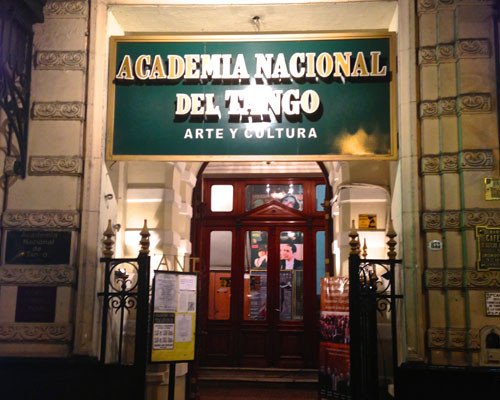
I head towards Avenida de Mayo. More precisely to Professor Enrique Binda’s second class.
Today’s class will covers some highlights of music and singing developments from 1922 to 1924. From a vintage edition of a De Caro’s book, Professor Binda shows us the picture of the orquesta Minotto where De Caro made his debut as the first violinist. We listen to “Fruta Prohibida” by Delfino, recorded by Victor in 1922. We notice the music to be rather repetitive. Without the variations, the subtleties or the expressivity that we had heard in the Fresedo orquesta last week. The Minotto orquesta had no particular characteristics, De Caro’s presence in it did not add anything, Binda says.
From 1922 we listen to “Viaje al Norte”, by Cobian’s sexteto, with its characteristic Cobian’s melody, with Petrucelli and Maffia in bandoneons, and Julio De Caro on violin. Binda and the knowledgeable members of this class find Cobian’s orquesta considerably less interesting than the rich Fresedo’s. (Anecdote: Cobian recorded this piece before he left for the United States in 1924, thus the title: “Trip to the North” [1924 is Binda’s research date, as opposed to the 1923 date find in publications]). Under his boss Cobian, Julio De Caro composed a tango named “Fresedo”, an expression of admiration and gratitude to the man who, since the 1910s had been the leading tango composer, arranger, and director. De Caro composed this tribute not to his boss Cobian, but to Fresedo.
Binda tells us anecdotes about De Caro’s early days as an orquesta director. He was hardly able to get good paying gigs and, to keep his orquesta together, paid his musicians out of his own pocket (without their knowledge); they performed at a bar a few blocks from the Academy of Tango in Avenida de Mayo. After about a month, when he was running out of money, a foreign impresario hired him to play at the luxurious Palais de Glace with a very high salary to play at dancing teas and dinners for the aristocracy. This unexpected success opened the door to recordings with the Victor company. This company had traditionally recorded cream of the crop musicians, while Odeon was less discriminating. To be recorded by Victor was, thus, a major step for De Caro.
“Todo Corazon” from August 1924 by De Caro’s sextet featured two bandoneons (Petrucelli [first bandoneon] and Maffia), and Francisco De Caro on piano. This is the only recording with these two bandoneon players. Petrucelli left soon thereafter and Laurenz joined. De Caro’s orquesta had far more liveliness than Cobian’s.
After listening to De Caro we listened again to “Sollozos” (1922), the Fresedo piece played during the previous class, with Cobian on piano, Roccatagliata in violin, and solos of bandoneon.
Binda reminds us that these great musicians were “practically children” between ages 22 and 24!
We spend some time appreciating how slow the development of singing was during the late 1910s and the 1920s. Singing lagged far behind the fast developing music.
In the rather mediocre voice of Ignacio Corsini, an actor who found his way into singing, we noticed his difficulties sustaining certain notes in “Patotero Sentimental” (1922). On the other hand, Rosita Quiroga, the “Gardel” female of tango song, recorded “De mi barrio” in 1923 as a full mature singer. She sang with expressiveness, invitingly, almost a cappella.
“Mia”, one of the first tangos that Azucena Maizani recorded in 1924, shows that it would take Maizani several years to achieve the quality that Rosita Quiroga had reached a year earlier.
With this recording Professor Binda closed the evening.
Impressed by my fellow students’ knowledge of tango music and history, I observed when Binda played specific songs (at times they dialogued with the teacher). I asked three of the men (as we descended down the white marble stairway hugging the turn of the century elevator) why were they attending this class if they knew so much. They had some “holes” in their knowledge and this teacher knows so much that it brings it all together for them, I was told. I was amazed one of them had identified “Almita Herida” during the two seconds Binda (by mistake) put it in the recorder and quickly removed it. Already in Avenida de Mayo at 9:30 PM, I asked him about his background. He was not a musician, not even a dancer, he replied. He had a “good ear”, a wide collection of recordings and loved tango. And you, they asked, what brings you to this class? “I come from dancing….” They seemed pleased and almost in unison they said: there is only one tango that cannot be separated: “music, dance, poetry and singing”.

